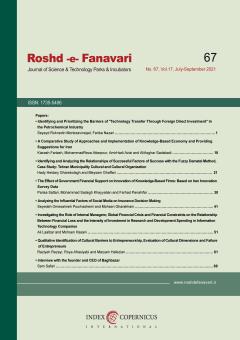-
-
List of Articles
-
Open Access Article
1 - Identifying and prioritizing the barriers of "technology transfer through foreign direct investment" in the petrochemical industry
seid rokn oldin mortazavinejad fariba nazari -
Open Access Article
2 - A Comparative Study of Approaches and Implementation of Knowledge-Based Economy and Providing Suggestions for Iran
Kiarash Fartash Mohammad Reza Attarpour Amirhadi Azizi Ali Asghar Sadabadi -
Open Access Article
3 - Identifying and Analyzing the Relationships of Successful Factors of Success with the Fuzzy Dematel Method, Case Study: Tehran Municipality Cultural and Cultural Organization
hadi heidari gharehbolagh meysam ghaffari -
Open Access Article
4 - The Effect of Government Financial Support on Innovation of Knowledge-Based Firms: Based on Iran Innovation Survey Data
parisa sattari mohammadsadegh khayyatian yazdi farhad panahifar -
Open Access Article
5 - Analyzing the Influential Factors of Social Media on Insurance Decision Making
Mohsen Gharakhani Seyedeh OmSalameh pourhashemi -
Open Access Article
6 - Investigating the Role of Internal Managers; Global Financial Crisis and Financial Constraints on the Relationship Between Financial Loss and the Intensity of Investment in Research and Development Spending in Information Technology Companies
Mohsen Hassani Ali lal bar -
Open Access Article
7 - Qualitative Identification of Cultural Barriers to Entrepreneurship, Evaluation of Cultural Dimensions and Failure of Entrepreneurs
royae afrassiabi maryam hafezian raziyeh rezayi
-
The rights to this website are owned by the Raimag Press Management System.
Copyright © 2017-2025







